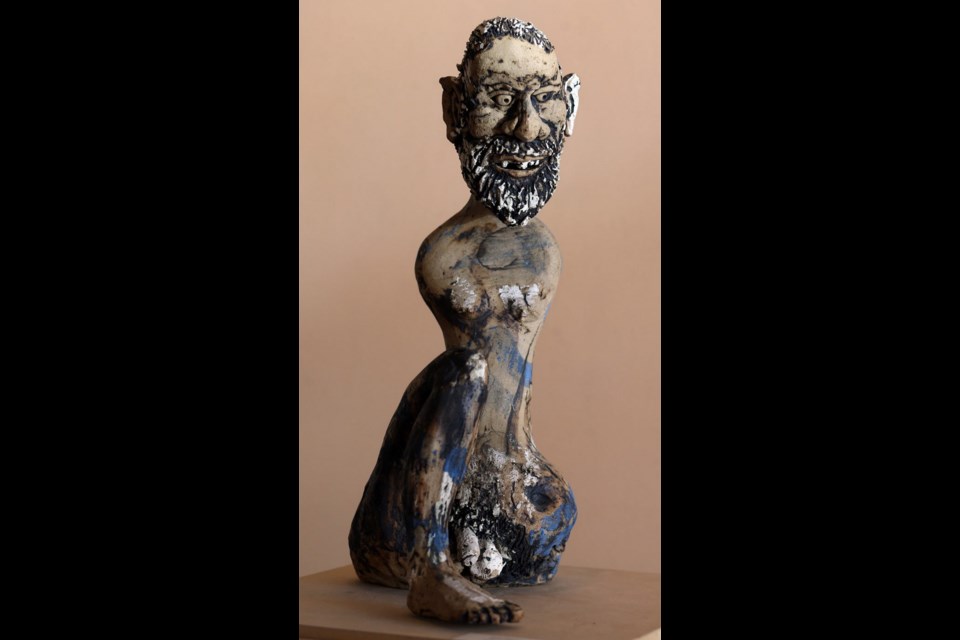 Artist David Toresdahl has been gone for 10 years now. His widow, Louise Bohun, and gallery owner Martin Batchelor thought it was time to give his powerful sculptural ceramics and mysterious drawings the attention they deserve. His rugged work gets better with age.
Artist David Toresdahl has been gone for 10 years now. His widow, Louise Bohun, and gallery owner Martin Batchelor thought it was time to give his powerful sculptural ceramics and mysterious drawings the attention they deserve. His rugged work gets better with age.
During his lifetime, I often wrote about Toresdahl’s figurative ceramics and his uncompromising view of the world. He moulded contorted, amputated characters, with eyes bugging out as they writhed in the existential void. Their flesh seemed a scarred and burnt crust. Now, as I reconsider the same pieces, they seem almost tender and introspective. Certainly, his work is ready for re-evaluation.
Born in 1939 in Austin, Minnesota, Toresdahl was a farmboy and an artist from his childhood. His worldview was inspired by personal conflict, for his family on his father’s side were Lutheran missionaries, and his mother’s parents were saloon keepers. Through his wild and reckless young life he suffered car crashes and injuries, and the scars can be seen in his art.
“Almost everything is a self-reflection, if not a direct self-portrait,” Bohun told me.
His first public showing came in 1962 at the Minnesota State Fair, but “music was the thing that sent him to art school,” Bohun said. “He was in a four-man singing group called the Saints.” When he arrived in California, it was their hit tune, Rock and Roll Ruby, that paid for his start at college. There he studied, worked and exhibited until 1970, making block prints and becoming expert in bronze casting. He graduated with a master’s degree in fine art from the University of California at Fullerton.
California artists were having a joyous time with their West Coast version of Pop Art, called Funk Art. Fun-loving and folksy, it was a rebuke to the high-mindedness of East Coast abstraction. Toresdahl was on the scene. And ceramic artists, inspired by Peter Voulkos, were moving beyond craft and functionalism, using clay for pure expression. Toresdahl was there, too. Along with fellow Funk-artist potter David Gilhooly, he was one of many Americans who made his way to Canada about 1970.
His was always a hermetic and very personal expression. So it comes as a surprise that in his first decade he was commissioned to create ceramic murals for the Surrey Arts Centre (1974) and the Federal Taxation Data Centre in Surrey (1979). Toresdahl’s “humongous ceramic wall mural” at the Taxation Data Centre is still powerful, according to Bohun. “You wanted to avert your eyes, it was so scary. It is so David, so in-your-face.”
Toresdahl worked at his professional career with exhibits throughout B.C. and in Ontario, but by the 1980s he had settled on Vancouver Island. His uncompromising statues were then seen only sporadically, mostly in galleries that no longer exist — Stones Gallery, the Beatrice Jumpsen Gallery and the Holland House Inn. A final show, under the aegis of Art Rental at the Art Gallery of Greater Victoria, featured at least 100 small ceramic heads.
Bohun met the artist in 1996 when they were both living at Lake Cowichan. Toresdahl was building sculptures by assemblage, taking shards and pieces from his production and cementing them together.
“He’d work all day long, and sell them cheap,” Bohun told me. An artist herself, Bohun is full of respect for Toresdahl and his attitude to life: “everything translated to a visual or a physical thing. If he looked a tree he would see faces; he arranged stones on the sidewalk.
“If there is one word I can think of for David,” she went on, “it’s intention. He made art with intention. He gave himself fully to the process, he was free there. Where some people see the grotesque and the ugly side [of his art], I see the beauty and the joy. Absolutely joyous, the wonder he still experienced. His great desire was not to lose that innocence, the creative childlike desire to make marks.” He never left the house without a sketchbook.
Toresdahl associated with many of the Limners art group in the 1980s, and with potter Walter Dexter he shared a mutual respect. But no one was closer in spirit than his friend Lance Olsen.
“David was an only child,” Bohun reported, “and Lance was like his brother.”
Working in a darkly comic style reminiscent of the late work of American Philip Guston, both artists expressed their feelings about the state of mankind. Olsen’s paintings and Toresdahl’s ceramic assemblages were often exhibited together, most notably at Holland House, a boutique hotel Olsen owned in James Bay during the 1990s. Toresdahl’s rugged heads and spinal columns never looked better than in that elegant context.
Sculptures and drawings by Toresdahl are scattered far and wide, and perhaps it’s time to begin an inventory. With the dignity of the Martin Batchelor Gallery display and the passing of time that has allowed a more measured appreciation, these tough constructions begin to look like ancient artifacts, like something buried at Pompeii. In fact, the artist once told Bohun: “I want them to think that they dug up a treasure stuck in the dust for 2,000 years.”
We could be digging up creations by David Toresdahl for years to come, and our admiration for them will continue to grow.
David Toresdahl: 1939-2004 at the Martin Batchelor Gallery, 712 Cormorant St., 250-385-7919, until Aug. 12.
